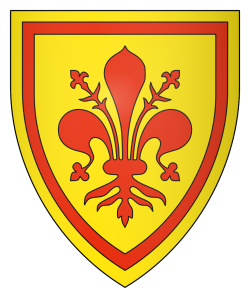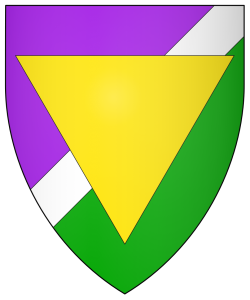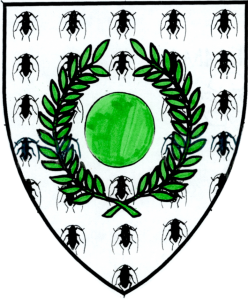My SCA persona is of mixed post-Viking Irish and post-Roman Welsh descent, living in northern Wales one thousand years ago, so I tried to select a name and armory that felt appropriate for that context.
 Per fess argent and vert, a bear passant gules.
Per fess argent and vert, a bear passant gules.
The Irish and Welsh of 1017 did not have a concept of personal armorial designs, which arrived in the British Isles with the Normans fifty years later, but heraldry is such a pervasive element in the SCA that I was willing to be anachronistic about it.
However, I still wanted to use a very simple design that was reminiscent of the earliest period of heraldry — per-fess fields with a single central charge are found by the twelfth century.
I also wanted a design that was suggestive of Ireland and Wales — the Welsh flag is white and green with a red dragon, and bears are important symbols in early Celtic mythology.
And the red bear makes a good symbol for me — I am heavyset, bearded, and somewhat red of face.
The above emblazon uses a bear illustration by Graham Johnston from Fox-Davies’s heraldry book of 1909. The submitted image uses a much cuter bear inspired by the “bear cub” cant mentioned below.
Mathghamhain Ua Ruadháin is a plausibly authentic Irish Gaelic name for the eleventh century. It’s pronounced something like Mah-(g)huw-ahñ Oh-ah Roo-ahñ, where the stress is on the underlined syllables and the parentheses indicate a softened guttural sound.
The word “Mathghamhain” is an old Gaelic word for bear cub, formed from the roots “matu” or “math” meaning bear, and “ghamhain” or “ghamhuin” meaning calf. In later usage this word shifted from meaning specifically a bear cub to referring to bears in general.
(A discussion of the importance of the bear in Celtic mythology and the derivation of the name Mathghamhain is provided by “Recherches sur l’origine de la propriété foncière et des noms de lieux habités en France”, Henri d’ Arbois de Jubainville, 1890, pp. 389-390, in French here, and translated to English here by Jeff McMahon.)
An old collection of Irish records known as the “Annals of the Four Masters” lists a dozen influential men named Mathghamhain in the years from the late 900s through the 1100s, including the older brother of Brian Bóruma mac Cennétig, aka Brian Boru, high king of Ireland.
Other period spellings of the name include Matgamain, Mathgamain, Mathghamain, Mathgamhain, Matghamhain, Matgamhain, Mathgamuin, and Mathgamhuin. (Much of this spelling diversity stems from the use of H as a marker for lenition — in Gaelic, a consonant followed by an H typically sounds quite different from that same consonant alone, generally being voiced more softly, or sometimes becoming totally silent. In early written Gaelic, lenition was originally indicated by putting a dot above the letter, so in the year 850 the name might have been written Maṫġaṁain, but later orthography switched to using an H after the letter instead. This transition happened unevenly in different times and places, with intermediate periods in which the lenition was implicit, or where the marker was applied only to certain consonants, or only when written in certain typefaces — and as old records were copied by later scribes, they would sometimes preserve the original spelling and other times would convert it to their contemporary usage, leaving an inconsistent mess.)
Mathghamhain can be pronounced Mah-hoo-an, although the period pronunciation may have been closer to Mah-(g)huw-ahñ. In modern Gaelic it’s pronounced something like Mah-hoon, and it’s typically Anglicized as Mahon, although in some cases it may have been converted to Matthew.
Ua is the marker for a clan affiliation byname; originally meaning “grandson of,” it later shifted to mean “descendent of” some notable ancestor, or more generally “member of a lineage.” This usage of Ua began in the late 900s in Ireland; by the 1200s, it was more generally written O’. It’s pronounced somewhere between “Oh” and “Oo-ah” and “Wah.”
Ua Ruadháin was a family name in Ireland by the late 11th century, and was well established in western Ireland in the 12th and 13th century.
Spelling variations include Ua Ruadáin, Ua Ruadhán, and Ua Ruaidhín.
It is a genetive patronymic form of Ruadhán (“the red”, or “little red one”), which was in use as a first name centuries before that, including the 6th C. Saint Ruadhán and the 10th C. Bishop Ruadhan. (The personal name also appears as Ruadan and Ruadhan.)
There are a fair number of clergymen named Ua Ruadháin, including Aedh Ua Ruadhain (priest, north Ireland, –1105), Maol Ruanaidh Ua Ruadháin (bishop, Connacht, –1170), and Felix O’ Ruadhan (archbishop, Tuam, 1201–1235).
Ruadháin can be pronounced Roo-ahn, although the period pronunciation may have been closer to Roo-a(g)hañ or Roo-ain. Modern Gaelic pronunciations seem to include Roo-ahn, Roo-awn, and Roh-an. It’s typically Anglicized as Ruane or sometimes Rowan, although in some cases it may have been converted to Ryan.
Thus, loosely translated, the name Mathghamhain Ua Ruadháin can be read as something like “bear cub of the little red one” or “bear, descendent of the red,” meaning that the device shown above acts as a rebus, or “canting arms,” which was a common practice in the medieval period, using a picture that suggests elements of the name either literally or via puns.
While the name would probably be Anglicized as Mahon O’Rowan, it’s not completely out of the question for it to have become Matthew Ryan — my given name and my mother’s Irish family name.
Name and device submitted at Pennsic Heralds’ Point in August 2016 and accepted on the January 2017 LoAR published that March.
The original blazon submitted described the central charge as a “bear cub,” as an attempted cant on the meaning of “Mathghamhain,” but this was declined on the grounds that SENA A2C1 forbids the registration of baby animals.
Due to a transcription error at Heralds’ Point, the byname was registered with one letter missing, which was corrected in an errata the following month.
The name and device were approved at the end of March, and I want to thank everyone who helped me as I worked through the process, including Alys Mackyntoich, who answered my EK “ask a herald” request early on in the process and helped me with Gaelic name elements; Seraphina Delfino, Rachael d’Amour, and Sigrith Vigdisardaater who checked my initial armory design in the Facebook SCA Heraldry Chat group and helped me figure out that turning the bear in my draft design would clear the only conflict; Frank Sloan and Brian Engler, who reviewed my Gaelic pronunciation; Gisela Vom Kreuzbach, who took my submission at Pennsic (as well as recruiting me to become a herald); Yehuda ben Moshe, who corrected a typo which I hadn’t noticed until much too late in the process; and the others whose names I’ve lost along the way — much appreciation to all.
 Or, a Florentine fleur-de-lys and on chief gules two mullets of eight points Or.
Or, a Florentine fleur-de-lys and on chief gules two mullets of eight points Or. Or, a Florentine fleur-de-lys within an orle gules.
Or, a Florentine fleur-de-lys within an orle gules.
 Per bend sinister purpure and vert, a bend sinister argent, overall an inverted triangle Or.
Per bend sinister purpure and vert, a bend sinister argent, overall an inverted triangle Or.







